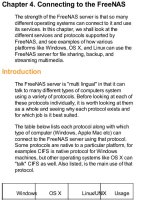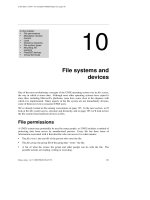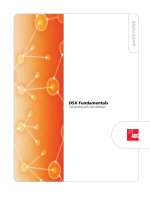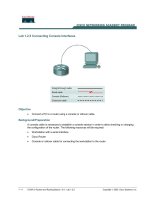Connecting networked devices
Bạn đang xem bản rút gọn của tài liệu. Xem và tải ngay bản đầy đủ của tài liệu tại đây (2.27 MB, 66 trang )
O’Reilly IoT
Connecting Networked Devices
Prototyping and Scaling IoT in the Enterprise
Alasdair Allan and Brian Jepson
Connecting Networked Devices
by Alasdair Allan and Brian Jepson
Copyright © 2017 O’Reilly Media, Inc. All rights reserved.
Printed in the United States of America.
Published by O’Reilly Media, Inc., 1005 Gravenstein Highway North,
Sebastopol, CA 95472.
O’Reilly books may be purchased for educational, business, or sales
promotional use. Online editions are also available for most titles
(). For more information, contact our
corporate/institutional sales department: 800-998-9938 or
Editor: Brian Jepson
Production Editor: Shiny Kalapurakkel
Copyeditor: Jasmine Kwityn
Proofreader: Amanda Kersey
Interior Designer: David Futato
Cover Designer: Karen Montgomery
Illustrator: Rebecca Panzer
November 2016: First Edition
Revision History for the First Edition
2016-11-10: First Release
The O’Reilly logo is a registered trademark of O’Reilly Media, Inc.
Connecting Networked Devices, the cover image, and related trade dress are
trademarks of O’Reilly Media, Inc.
While the publisher and the authors have used good faith efforts to ensure
that the information and instructions contained in this work are accurate, the
publisher and the authors disclaim all responsibility for errors or omissions,
including without limitation responsibility for damages resulting from the use
of or reliance on this work. Use of the information and instructions contained
in this work is at your own risk. If any code samples or other technology this
work contains or describes is subject to open source licenses or the
intellectual property rights of others, it is your responsibility to ensure that
your use thereof complies with such licenses and/or rights.
978-1-491-96404-0
[LSI]
Preface
We’re accustomed to yearly, or faster, upgrade cycles. A new phone each
year, a new laptop every couple of years, and each year the slabs of
aluminum, plastic, glass, and silicon get a little bit thinner and weigh a little
bit less. And from that shift, even smaller devices have begun to appear, and
everyday objects are becoming smarter.
Because of this, computing is slowly diffusing into our world. A decade from
now, everything important will be measured and observed in real time. But
right now almost all of the devices that will one day will be connected to the
network aren’t.
When most people think about big data, they think about it living out in the
cloud. However, at the moment, the amount of data that lives on systems that
aren’t connected to the network, or are unreliably connected to the network,
vastly outweighs the data that lives in the cloud. As more smart, connected
devices come online that can push that data to the cloud, all this data which
had previously been locked away will become available.
Right now, this infrastructure is being built, and chances are good you’re one
of the people building it. As you connect networked devices — to one
another and to the cloud — you’ll need to consider many factors, including
your product’s relationship with its environment, how your prototyping
process considers its constraints, your developers’ user experience, and the
physical operating environment. And you’ll do this all while balancing time
to market, common sense, and security.
Products, Platforms, and Strategies
Over the last few years, many companies have introduced platforms and
products designed for the Internet of Things (IoT). These products often are
either just proprietary middleware and services, or are simply embedded
electronics, with or without the addition of a network connection. Just adding
a network connection to an existing device doesn’t make it part of the
Internet of Things.
In an environment that is rapidly changing, and will continue to be volatile
for several more years before best practices, or even just accepted practices,
start to emerge, designing your product will depend heavily on a number of
factors: naturally, the requirements are important, but there’s also the refresh
cycle, time to market, physical environment, and how the device will connect
to the network. One of the key problems in the current generation of Internet
of Things devices is the refresh cycle problem. Enterprises reap the benefits
of two- to three-year refresh cycles in computers and mobile phones; with
new hardware and software come bug fixes for security. IoT devices are
generally part of systems that are expected to run for many years, even
decades, with minimal intervention (and minimal opportunity to perform
software updates).
The design of your product will be heavily influenced by the typical refresh
cycle in your area of business, and governed not just by the time to market,
but also the amortization of nonrecurring engineering costs, and lifetime units
sold.
The physical environment into which the product will be placed must also be
taken into account. Computers, and network connected devices, no longer
live in the server room — they’re out in the world interacting with dirt, dust,
water, and people.
That change in location also changes the way the device must be powered
and connected to the network; in addition, it affects the options you have
available for connecting a networked device and determines how you will
exercise those options.
Chapter 1. Where Does Your
Product Sit?
The dot-com revolution happened in part because, for a few thousand or even
just a few hundred dollars, anyone could have an idea and build a software
startup. Today, for the same amount of money, you can build a business
selling goods or software, and both your product and the process by which
you develop it are augmented because devices and people can communicate
and connect across the globe.
Project Requirements
Everything begins with how users will interact with your device, and how it
will interact with both them and the network. In other words, where will your
product sit in the hierarchy of connected devices?
Local, Edge, or Cloud?
In general, connected devices can be roughly split into three broad categories:
local devices, edge devices, and cloud-connected devices.
Local devices don’t have the capability to reach the Internet, but they are still
connected in a network. This network usually isn’t TCP/IP based. For
instance, both ZigBee and Bluetooth LE devices are good examples of
network-connected things that operate locally rather than directly connected
to the Internet, and illustrate the two types of local networking. In the case of
ZigBee, the device operates in either mesh or peer-to-peer mode, with
packets hopping between devices until they reach a gateway on the edge of
the local network. In the case of Bluetooth LE, the device operates in either
paired or broadcast mode, with messages being picked up directly by a device
on the edge of the network.
Edge devices typically have multiple radios, and operate in both local and
connected modes — for instance, utilizing ZigBee or Bluetooth LE to talk to
a local non-TCP/IP network, but also fully supporting a TCP/IP connection to
the outside world. They act as a bridge, or gateway, between a local network
and the outside world, typically forwarding data received from a local
network of sensor devices to the cloud, or sending commands to a network of
actuators from the cloud.
Cloud devices connect directly to a TCP/IP network, in most cases using
WiFi or cellular, and wired devices also count in this category. They’re
distinct from edge devices in that they typically don’t communicate via a
local network to other network-enabled devices. If they are part of an
extended network of smart, connected devices, all the communication is
normally funnelled via the cloud.
Prioritizing Your Decisions
Although it’s tempting to imagine that a single protocol and network stack
will come to dominate the IoT, it is in fact unlikely that this will happen. The
history of the Internet suggests that the IoT will remain diverse in the
protocols and architectures used.
If you want to deploy devices in massive quantities, cost management means
it is likely that these devices will have the minimum viable specification that
is required to do the task at hand. The purchase decisions you make may
constrain future options as far as which protocols are available to you.
It’s possible that some convergence will happen at the highest level of the
protocol stack, with the data exchange formats tending toward a single
standard, while all the underlying transport protocols remain diverse. This is
almost the opposite of the existing digital Internet, where a diverse number of
low-level networking protocols have been effectively replaced with TCP/IP,
layered on top by a large number of other higher-level transport protocols and
document standards.
Designing the Minimum Viable Product
A minimum viable product (MVP) is a product (rather than a prototype) that
you deploy to customers, with the minimum set of features you need to
gather information on how it is used so that you can refine it. Typically,
you’d roll out the MVP to a small group of customers, and for each major set
of refinements, expand that group. In the software world, this approach is
popular and successful because of the relative ease of updating software in a
cloud-based world.
However, the story of hardware development is somewhat different. While
the concept of a minimum viable product still exists and is useful, building
hardware tends to led by design rather than by feature. That results in two
prototypes being built, a “looks like” and a “works like” prototype. The
“looks like” model, true to its name, looks like the final product, but has little
— or sometimes none — of the intended functionality. The “works like”
prototype behaves like the final product, but generally bears no outward
resemblance to the final product in terms of industrial design.
Confusing the “looks like” and “works like” prototypes, or mixing them,
leads to what’s commonly referred to as feature-driven design. For hardware
products intended for the IoT, this leads to poor user interaction with the
product. That’s caused by design decisions you didn’t make, instead
offloading design decisions to the user. If you make these design decisions
once, users won’t have to go through that decision tree every time they use
the product.
The Standards Problem
As we alluded to earlier, there is a brewing — if not all-out — standards war
ongoing in the IoT. There is a great deal of confusion around protocols at
different levels of the networking stack. For instance, there is a fundamental
difference between low-level wireless standards like ZigBee or WiFi, and
much higher-level concepts such as TCP/IP or above that HTTP and “the
web” which sits on top of the TCP/IP networking stack. Above even that are
document-level standards like XML and JSON, and even more conceptually
wooly things such as patterns.
For instance, the concept of RESTful services is effectively a design pattern
built on top of document- and high-level networking protocol standards. It is
not in itself fundamental, and is unrelated to the underlying hardware, at least
if the hardware itself is capable of supporting an implementation of these
higher-level protocols.
However, perhaps the greatest standards problem with the IoT is that, due to
constraints in power or computing resources, it is a mess of competing and
incompatible standards at the lowest level. Factors such as range, data
throughput requirements, power demands, and battery life dictate the choice
from a bewildering array of different wireless standards.
The Big Three
The big three, the most familiar to consumers and to developers, are
Bluetooth, WiFi, and cellular.
The most obvious choice, perhaps even the default choice, for networking an
IoT device is the WiFi standard. It offers good data rates, and reasonable
ranges (of the order 150 feet or larger), and means your device can connect
directly to the Internet if needed. However, WiFi devices with even moderate
duty cycles are power hungry.
Bluetooth, especially the low-energy configurations intended for low data
rates and limited duty cycles, is designed for personal (wearable) devices
with limited ranges and accessories. While recent standards revisions include
support for direct Internet access via 6LoWPAN (IPv6), there is still only
limited support that effectively means that Bluetooth devices are restricted to
local, and small, networks spanning (despite manufacturers claims) around 30
or 50 feet. In the shortest-range use cases (a few inches), you should also be
looking at near-field communication (NFC).
Of the three, perhaps the most ubiquitous, with the widest deployment and
market penetration, is cellular. If your cell phone can get signal in a location,
so can an IoT device with a 2G or 3G module onboard. Data rates lie
somewhere between WiFi and Bluetooth, with the main advantage being
range. Cellular devices can be located up to 20 miles from a cell tower, and
depending on intervening obstacles, still get reception. However, cellular is
both power hungry and expensive to operate. While GSM may be a good
choice for a gateway device, it’s unlikely to be a good fit for most IoT
devices.
Mesh Networks
Standards such as ZigBee and Z-Wave fill a niche in the local networking
space. While they need a gateway device to talk to the Internet, both
standards have mesh networking capability, so while individual devices can
have between 30- to 300-foot range, the size of the network is actually only
limited by the number of devices deployed. Both ZigBee and Z-Wave are
targeted for low-power applications with lower data rates.
While ZigBee and Z-Wave have been around for a while, newer IPv6
protocols, such as Thread, which are based around a basket of standards
including 6LowPAN, offer mesh networking and direct access to the digital
Internet so long as IPv6-capable networking gear is in place. Designed to
stand alongside WiFi, IPv6-based protocols such as Thread are attempting to
address the lack of TCP/IP at the lowest levels of the IoT, accepting that the
high-powered WiFi standard may be inappropriate for many (if not most) IoT
devices.
Wide Area Networks
While cellular (typically GSM or UMTS) is the most popular standard used
to provide wide area networks (WAN), there exist other newer standards that
attempt to provide this functionality at much lower costs.
Sigfox uses the ISM radio bands, with typical operational ranges of up to 30
miles in rural environments and as low as 6 miles or less in urban
environments. Sigfox networks are being rolled out in major cities across
Europe and the United Kingdom. Making use of ultra-narrow band signaling,
it is intended for very low data rates (just 10 to 1,000 bps) but also very lowpower deployments (consuming a factor of 100 less power than cellular).
Other alternatives include Neul, which leverages the small slices of
whitespace spectrum between the allocated TV bands and has a range of
around 6 miles, and perhaps the most well known of the three, LoRaWAN.
LoRaWAN has a range of up to 3 miles in an urban environment and perhaps
9 or 10 miles in a suburban environment. Its rates range from 0.3 kbps up to
as high as 50 kbps, and it makes use of various frequencies, depending on
deployment. Much like Sigfox, it is also optimized for low-power
deployments and large (millions of devices) deployments. The first LoRa
network with nationwide coverage was rolled out in June 2016 in the
Netherlands by the Dutch telecoms group KPN.
Chapter 2. Starting with One
When you’re building a connected device, you’re building for a lot of
different people. But no matter how someone uses your device and its
associated stack of services, your users will fall into one or both of the
following roles:
Users
These are the people who interact directly with the device or its data.
They need the device to be on and available when it’s supposed to be,
and they expect the same for its data.
Developers
Every device needs some degree of integration and ongoing
maintenance. The developers take your device (and its APIs) and
connect it into their internal or customer-facing systems. They might be
full stack hardware developers, or they might work at one of the levels
in the stack: from firmware customization to adding new peripheral
devices, on up to developing cloud analytics to work with the data, and
anywhere in between.
A third role — hardware power users — emerges when someone falls into
both of the preceding categories. Hardware power users might be users 80%
of the time, but use scripting or plug-in tools to customize their experience.
Each role needs a different set of affordances and features, and will have
different expectations about response time and access. A user might need
smartphone access to a dashboard that’s updated every second, but she
doesn’t need to access the device’s serial port remotely. A developer might
need the ability to push over-the-air firmware updates to a device, but he
doesn’t need to receive notifications when it’s time to replace a refrigeration
unit that his device is monitoring.
However, your device has the weight of the world on its shoulders. It has to
support all those scenarios, and look good doing it.
A prototype often starts with a breadboard, some components, a
microcontroller board, and some ideas. It’s tempting to throw every feature
imaginable into the device. But just because something is possible it doesn’t
mean it is compulsory. Adding extra controls or displays to a product is a
classic mistake at this stage of the product life cycle. It increases the cost of
each unit and introduces cognitive overhead the users and developers must
bear.
Over the last few years, we’ve finally reached a point in the software design
world where we’ve figured out that offering choice to the user isn’t always
the best thing to do. More choice isn’t a virtue in and of itself, and sometimes
it can introduce confusion. Every control you add — to software or hardware
— is a design decision you aren’t making, where you’re offloading the design
of your interface onto the user. Make the decision once so your user doesn’t
have to make the decision several times a day.
Know Your Device’s Role
Where does your device sit? What is its role? Edge device or gateway? More
and more, the answer is both.
As connected devices are increasingly deployed into every corner of our
environment, the need grows for them to be self-sufficient. More and more
wireless modules, such as those from Espressif and Nordic, have a
microcontroller that can run custom code and interface directly with sensors
over GPIO, I2C, and SPI.
Sensors can also gather a tremendous amount of data. With a low-bandwidth
or limited-data connection such as a cellular connection, it’s ideal for the
device to do as much processing on the data as possible before relaying it to
the cloud.
As you develop your prototype, you’ll understand its role better. How much
will your device do on its own? Will it just relay raw sensor readings to a
central gateway device? Will it read sensor readings, perform some
processing, and then relay it to a gateway? Or is the device itself the gateway,
reading sensors, processing data, and sending it on to the cloud
independently?
The answers to those questions will come from the physical (and software)
environment you are deploying in as much as which hardware choices you
make.
Don’t Fall in Love with Your Parts Bin
For the prototype, where you’re just throwing components onto a breadboard
as fast as possible, it’s sometimes convenient to use whatever you have on
hand. That can be a good thing if you’re an experienced product engineer,
and your parts bin consists of things that you’ve used in other successful
projects.
But new components, whether new generations of existing parts, or entirely
new parts, become available quite regularly. When Espressif introduced the
inexpensive ESP8266, it was a big deal for prototypers. Here was an
inexpensive module ($2 in single-unit quantities) that not only could be used
to add WiFi networking to a prototype or a device, but could itself be
programmed. In many prototypes, the $2 ESP8266 has enough I/O and
processing power to completely replace both an Arduino and WiFi module.
This device came to attention in mid-2014, and by mid-2016, its use was
widespread.
In addition to keeping on top of new and emerging components, you need to
maintain reliable standbys in your parts bin. Because choices made at the
start of engineering design have a tendency to become set in stone as the later
prototypes evolve, you can’t afford to prototype with a component that has
reached end-of-life. Therefore it’s important, especially if you’re building a
hardware product for the first time, to fill your parts bin with parts that are
easy to source. Readily available parts are more affordable, resulting in a
lower bill-of-materials cost, and can be sourced from multiple manufacturers
if needed, resulting in a more reliable supply.
Several contract manufacturing companies have established parts catalogs to
advise your parts choices. For example, SeeedStudio has compiled an Open
Parts Library (OPL) catalog, which is a collection of the most commonly
used components. If you’re working with Seeed, using OPL components in
your design means that Seeed will have sufficient stock to fulfill on short lead
times, at lower costs than other components.
Other sites, such as Parts.io, exist to simplify the component discovery
process. Using these types of sites when considering your parts choice means
that you can manage exposure to supply chain risk. You can get feedback not
just on the availability of the part, but also the life-cycle stage of the
component, and variation in cost over time and between competing
suppliers.1
When assessing whether a component should be designed into a product in
the first place, it’s important to consider not just whether it’s available now,
but whether it’ll be available over the entire life cycle of your product. While
some components may only have a single source, you should always try to
find a more common substitute. Supply volatility of components can leave
you unable to find a critical component, which could lead to your product
being retired from the market early or a costly mid-life-cycle redesign of your
product.
Creating a Bill of Materials
You may start most products with a single model, but eventually, you’ll need
to make many. Whether a dozen, one hundred, or one million, you’re going
to need to make more than one.
The critical starting point for mass production is your bill of materials, which
serves as the list of ingredients for building the product.
From the information contained in the bill of materials, it should be possible
to determine the lead time to procure the materials necessary for production,
the manufacturing processes necessary to bring them together, and the time to
manufacture and ship the product.
While most companies understand the importance of the bill of materials,
there is little consistency in format, and that can add friction when dealing
with contract manufacturers. To combat this, there have been several
attempts2 to produce standard bill-of-materials templates (e.g., the Dragon
Standard BOM4) and, especially for first-time product builders, these can be
invaluable.
Code and Hardware
In recent years, hardware has come to be seen as “software wrapped in
plastic.” While it’s not a popular view with hardware engineers, these days
the code running on your hardware can be just as important if not more so
than the hardware itself. Like design, in an age where all things that are
buildable are rapidly copyable, the software running on your device may
prove to be even more important than the hardware it runs on.
You should also consider the possibility that your code can be used again and
write your code for reusability. If you’re building one product, it’s likely you
may build a second version, or a third. As such, it’s important to separate the
code that talks directly to the hardware of your device — the dials, sliders,
buttons, knobs, and other physical things — from the code that talks to the
network.
With the drop in the cost of computing — both in terms of price and power
consumption — many manufacturers are now basing their connected devices
around relatively powerful processors. A common pattern emerging in this
space is to have the code that talks to the hardware running as a separate
process from that which implements the functionality of the networked
device. This code, which may be written in a much lower-level language than
the application which manages the rest of the connected device, often uses a
REST or other network-level API to talk to the management code.
This means that the bulk of your device code can be written in a higher-level
language, decreasing developer time and increasing your pool of
development talent. But it also means that the management code can expose
command and control functionality in just one place. The same API used by
the device’s own hardware can in turn be exposed by the device’s network
interface and used to control it from some other network device.
What About the Network?
As you develop your prototype, you will make decisions about how to
connect to the network, and how to move data from device to cloud. If your
device is both an edge device and a gateway, and is connected directly to a
WiFi, wired Ethernet, or cellular network, you’ll be in well-worn territory.
But if you’re not directly connected to a network, and you need to use a
gateway of some sort, you’ll have to decide how that’s handled:
Are the devices clustered together? Maybe adding Bluetooth or ZigBee
to your gateway and edge devices is the answer.
Are the devices spread out all over the place? Maybe LoRa or cellular is
the way to go here.
What is the ratio of gateways to devices? If you have fewer highly
mobile devices, you might be scaling up the number of gateways rather
than the number of devices.
You may start with only one, but you will scale to many. And even when
you’re done with the first, it’s not unreasonable to think that new versions
and new products will soon follow. This chapter shared some guidance on the
trickier parts of the process: making sure your product is approachable by the
different developer and user roles, understanding your device’s relationship
to systems large and small, the parts that actually go into your device, and the
software and network connectivity considerations you need. The next chapter
looks in more detail at the relationship between your device and its users and
developers.
1
For more information, see Parts.io’s blog post “Improving RiskRank.”
2
See Dragon Innovation Blog’s post “Introducing the Dragon Standard BOM”.









